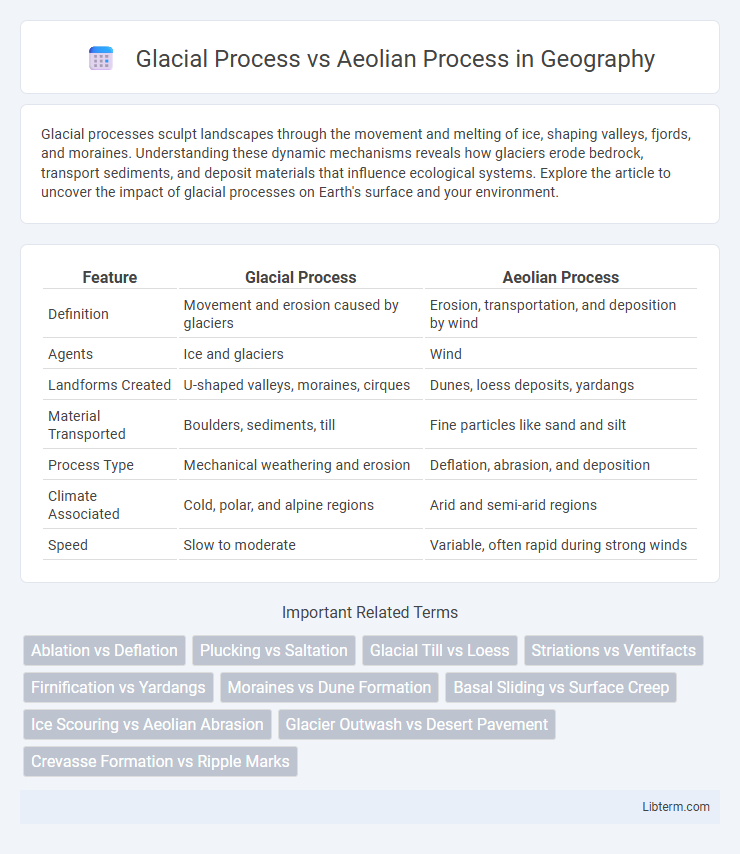Glacial processes sculpt landscapes through the movement and melting of ice, shaping valleys, fjords, and moraines. Understanding these dynamic mechanisms reveals how glaciers erode bedrock, transport sediments, and deposit materials that influence ecological systems. Explore the article to uncover the impact of glacial processes on Earth's surface and your environment.
Table of Comparison
| Feature | Glacial Process | Aeolian Process |
|---|---|---|
| Definition | Movement and erosion caused by glaciers | Erosion, transportation, and deposition by wind |
| Agents | Ice and glaciers | Wind |
| Landforms Created | U-shaped valleys, moraines, cirques | Dunes, loess deposits, yardangs |
| Material Transported | Boulders, sediments, till | Fine particles like sand and silt |
| Process Type | Mechanical weathering and erosion | Deflation, abrasion, and deposition |
| Climate Associated | Cold, polar, and alpine regions | Arid and semi-arid regions |
| Speed | Slow to moderate | Variable, often rapid during strong winds |
Introduction to Glacial and Aeolian Processes
Glacial processes involve the movement and deformation of ice, shaping landscapes through erosion, transportation, and deposition of sediments known as till. Aeolian processes refer to the wind-driven transportation and deposition of loose, dry particles, forming distinctive landforms such as dunes and loess deposits. Both processes significantly contribute to Earth's surface dynamics, with glaciers dominating cold climates and aeolian action prevailing in arid and semi-arid regions.
Definition and Overview of Glacial Processes
Glacial processes involve the movement and transformation of ice masses, such as glaciers and ice sheets, which shape the landscape through erosion, transportation, and deposition of sediments. These processes include plucking, abrasion, and the formation of landforms like moraines, drumlins, and U-shaped valleys, driven by the pressure and flow of glacial ice. In contrast, aeolian processes are driven by wind action, primarily affecting arid and semi-arid environments by transporting and depositing sand and dust to create features like dunes and loess deposits.
Definition and Overview of Aeolian Processes
Aeolian processes refer to the erosion, transportation, and deposition of sediments by wind, primarily affecting arid and semi-arid environments where vegetation is sparse. These processes shape landforms like dunes, loess deposits, and deflation basins through mechanisms such as saltation, suspension, and surface creep. In contrast, glacial processes involve the movement of ice masses that erode and reshape landscapes through plucking, abrasion, and deposition of till.
Sediment Transportation Mechanisms
Glacial processes transport sediment primarily through mechanisms such as plucking, where ice freezes onto rock and pulls pieces away, and abrasion, where embedded debris grinds against bedrock, resulting in finely ground sediment called glacial flour. Aeolian processes rely on wind to move sediments using saltation, which is the hopping or bouncing of sand-sized particles, suspension, carrying fine particles like silt or clay over long distances, and surface creep, where larger particles roll or slide along the ground. The efficiency and scale of sediment transportation differ, with glaciers capable of moving diverse sediment sizes within ice mass movement, while aeolian transport is typically limited to finer materials mobilized by wind energy.
Landforms Created by Glacial Activity
Glacial processes sculpt landscapes through erosion and deposition, forming distinctive landforms such as U-shaped valleys, fjords, and moraines composed of till. Cirques and aretes result from glacial plucking and abrasion, while drumlins and eskers demonstrate sediment reshaping by glacial meltwater. These features contrast with aeolian landforms, which are primarily shaped by wind-driven processes like dunes and loess deposits.
Landforms Produced by Aeolian Activity
Aeolian processes shape distinctive landforms such as dunes, loess deposits, and yardangs through wind erosion, transportation, and deposition of sediments. These features characterize arid and semi-arid environments where fine particles are lifted and redeposited, forming crescent-shaped barchan dunes, linear dunes, and extensive loess plains essential for soil fertility. Wind abrasion and deflation sculpt yardangs, streamlined ridges oriented parallel to prevailing winds, demonstrating the erosive power of aeolian activity.
Erosional Features: Glacier vs. Wind
Glacial erosional features include U-shaped valleys, cirques, and fjords formed by the movement of ice that scours and carves the landscape. Aeolian erosional features primarily consist of deflation hollows and ventifacts created by wind abrasion and the removal of loose sediment in arid environments. These processes result in distinctly different landforms: glaciers sculpt smooth, deep valleys while wind erosion produces sharp, abrasive surfaces on rocks and soil.
Depositional Features: Moraines vs. Dunes
Moraines are depositional features formed by glacial processes, consisting of accumulated rock debris and sediment transported and deposited by glaciers, typically creating ridges or mounds along the glacier's edge or terminus. Dunes are depositional features resulting from aeolian processes, where wind transports and deposits sand particles, forming various shapes such as crescentic, linear, or star dunes in desert or coastal environments. Both features illustrate distinct sedimentary environments, with moraines indicating past glacial activity and dunes evidencing active wind-driven sediment movement.
Environmental Conditions Favoring Each Process
Glacial processes occur primarily in cold environments where temperatures remain below freezing for extended periods, allowing ice sheets and glaciers to form and reshape the landscape through erosion and deposition. Aeolian processes dominate in arid and semi-arid regions with sparse vegetation, where strong, persistent winds transport and deposit sediments like sand and dust. Elevation, temperature fluctuations, and moisture availability are critical environmental conditions that determine whether glacial or aeolian processes prevail in shaping the terrain.
Comparative Impacts on Landscape Evolution
Glacial processes reshape landscapes through erosion, transportation, and deposition of sediments, creating distinctive features such as U-shaped valleys, moraines, and fjords. Aeolian processes contribute to landscape evolution by mobilizing and depositing fine particles, leading to the formation of dunes, loess deposits, and desert pavements. While glaciers exert a more dramatic and deep-reaching impact on topography, aeolian activity predominantly modifies surface environments, significantly influencing arid and semi-arid regions.
Glacial Process Infographic

 libterm.com
libterm.com